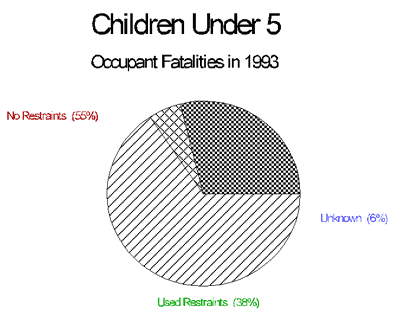















Traffic Tech #102: Strategies to Increase Car Seat Use in Rural Areas |
|---|
|

Number 102 July 1995
STRATEGIES TO INCREASE CAR SEAT USE IN RURAL AREAS
The National Highway Traffic Safety Administration (NHTSA) has published a guide for developing and implementing programs to increase infant and toddler car seat use in rural areas. Based on the results of research completed earlier this year, the guide responds to safety problems identified by national data. According to NHTSA's Fatal Accident Reporting System (FARS), most young children killed in crashes were not using safety restraints at the time of the collision. Moreover, rural areas are overrepresented in vehicle-related deaths of young children according to geodemo-graphic analyses linking crash fatalities to zip codes.
NHTSA sponsored a series of focus groups with young mothers in rural Georgia and Tennessee to identify ways to increase car seat use in rural areas. These states were selected because they had more child crash fatalities than would be expected for their population. Consistent with the racial majorities in the counties that served as information collection sites, the Georgia groups consisted entirely of young black mothers and the Tennessee groups were young white mothers.

A first wave of focus groups gathered details about rural lifestyle characteristics, motivational sources, media preferences, and car seat usage. This information was used to develop safety messages and artwork that were then tested during a second wave of focus groups. While some findings from the study may be specific to these locations, most results should generalize to other rural areas inside and outside the South.

Young Mothers in Focus Groups Preferred
This Simple Artwork Showing a Family
General guidelines to increase car seat use for infants and young children are featured at the beginning of the report. Other chapters expand program issues. For example, the section on delivery channels identifies the types of places frequented by the young mothers, important influencers in their lives, their sources for community information, and their media preferences. Health providers emerged as an important avenue for accessing the women with safety messages. Another frequent point of contact are discount department stores. While television and radio were the favorite sources of media entertainment, the effectiveness of using these media to communicate safety messages was questioned.
Another chapter on program implementation describes potential community activities to promote car seat use. Events include sporting events, festivals, health fairs, and county agricultural fairs. Other sections in the report review motivational themes and visual formats preferred by the young mothers. The women favored messages that were direct and serious, and liked artwork that portrayed a family scene.
The report concludes with a discussion of group differences that hold important implications for program development. The Georgia and Tennessee participants differed in media use, message preferences, and visual preferences. While both groups preferred a strong life and death message, the mothers in Georgia preferred a harsher message while those in Tennessee preferred a more nurturant one. Program practitioners will want to gauge this critical dimension in designing their programs.
For additional information, contact Alan Block at (202) 366-6401. To obtain a copy of Program Strategies For Increasing Car Seat Usage In Rural Areas (37 pages plus appendices), prepared by Lisboa Associates, Inc., contact: Office of Program Development and Evaluation, NHTSA, NTS-30, 400 Seventh Street, S.W., Washington, DC 20590, (202) 366-2752, or send a fax to (202) 366-7096.
U.S. Department of Transportation
National Highway
Traffic Safety
Administration
400 Seventh Street, S.W. NTS-33
Washington, DC 20590
Traffic Tech is a publication to disseminate information about traffic safety programs, including evaluations, innovative programs, and new publications. Feel free to copy it as you wish.
If you would like to receive a copy contact:
Linda Cosgrove, Ph.D., Editor,
Evaluation Staff Traffic Safety Programs
(202) 366-2759
